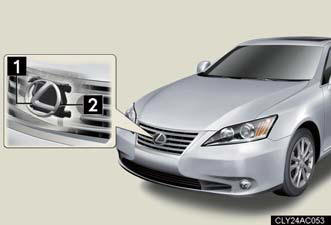PCS (Pre-Collision System)
When the radar sensor detects an unavoidable frontal collision, safety
systems
such as the brakes and seat belts are automatically engaged in an
attempt to lessen damage.
Pre-collision seat belts
If the pre-collision sensor detects that a collision is unavoidable, the
precollision
system will retract the seat belt before the collision occurs.
The same will happen if the driver makes an emergency braking or loses control of the vehicle.
However, when the TRAC/VSC systems are disabled, the system will not operate in the event of skidding.
Pre-collision brake assist
Applies greater braking force in relation to how strongly the brake pedal is depressed.
Radar sensor

Detects vehicles or other obstacles on or near the road ahead and determines whether a collision is imminent based on the position, speed, and heading of the obstacles.
1. Grille cover.
2. Radar sensor.
Obstacles not detected
The sensor cannot detect plastic obstacles such as pylons. There may also be
occasions
when the sensor cannot detect pedestrians, animals, bicycles, motorcycles,
trees, or snowdrifts.
The pre-collision system is operational when
Pre-collision seat belt (linked to the radar sensor) Х Vehicle speed is above 3 mph (5 km/h).
Х The speed at which your vehicle is approaching the obstacle or oncoming vehicle exceeds 18 mph (30 km/h).
Х The front occupants are wearing a seat belt.
- Pre-collision seat belts (linked to brake operation) Х Vehicle speed is above 9 mph (15 km/h).
Х The system detects sudden braking or skidding.
Х The front occupants are wearing a seat belt.
- Pre-collision brake assist Х Vehicle speed is above 18 mph (30 km/h).
Х The speed at which your vehicle is approaching the obstacle or the vehicle is greater than about 18 mph (30 km/h).
Х The brake pedal is depressed.
Conditions that may trigger the system even if there is no danger of collision
When there is an object by the roadside at the entrance to a curve - When passing an oncoming vehicle on a curve.
- When driving over a narrow iron bridge.
- When there is a metal object on the road surface.
- When there is a metal plate in the road in front of the vehicle on a downhill slope.
- When there is a metal object such as a sign board in front of the vehicle on
an
uphill slope.
- When driving on an uneven road surface.
- When passing an oncoming vehicle on a left-turn.
- When your vehicle rapidly closes on the vehicle in front.
- When your vehicle is skidding with the VSC system off.
When the system is activated in the situations described above there is also a
possibility
that the seat belts will retract quickly and the brakes will be applied with a
force
greater than normal. When the seat belt is locked in the retracted position,
stop the
vehicle in a safe place, release the seat belt and refasten.
When there is a malfunction in the system
Warning lights and/or warning messages will turn on or flash.
Certification
 For vehicles sold in U.S.A.
For vehicles sold in U.S.A.
FCC ID: HYQDNMWR005
This device complies with Part 15 of the FCC Rules. Operation is subject to the
following
two conditions;
(1) This device may not cause harmful interference, and
(2) This device must accept any interference received, including interference
that
may cause undesired operation.
FCC WARNING:
Changes or modifications not expressly approved by the party responsible for
compliance could void the user's authority to operate the equipment.
Radio frequency radiation exposure Information:
This equipment complies with FCC radiation exposure limits set forth for an
uncontrolled
environment.
This equipment should be installed and operated with minimum distance of 20 cm between the radiator and your body.
This transmitter must not be co-located or operating in conjunction with any
other
antenna or transmitter
 For vehicles sold in Canada
For vehicles sold in Canada
Operation is subject to the following two conditions;
(1) This device may not cause interference, and
(2) This device must accept any interference, including interference that may
cause
undesired operation of the device.
CAUTION:
Handling the radar sensor
Observe the following to ensure the pre-collision system can function
effectively.
- Keep the sensor and front grille clean at all times.
Clean the sensor and front grille with a soft cloth so you do not mark or damage them.
- Do not subject the sensor or surrounding area to a strong impact.
If the sensor moves even slightly off position, the system may malfunction. If
the
sensor or surrounding area are subject to a strong impact, always have the area
inspected and adjusted by a Lexus dealer.
- Do not disassemble the sensor.
- Do not attach accessories or stickers to the sensor, grille guard or
surrounding
area.
- Do not modify or paint the sensor and grille cover.
Limitations of the pre-collision system
Do not rely on the pre-collision system. Always drive safely, taking care to
observe
your surroundings and checking for any obstacles or other road hazards.
See also:
If the shift lever cannot be shifted from P
If the shift lever cannot be shifted with your foot on the brake, there
may be
a problem with the shift lock system (a system to prevent accidental operation
of the shift lever). Have the vehicle ...
Vehicle Overview
The Lexus GX 470 is positioned between the automaker's car-based RX 330 and
the premium-luxury LX 470. Equipped with full-time four-wheel drive, the GX 470
promises the luxury appointments and wor ...
Cleaning and protecting the vehicle exterior
Perform the following to protect the vehicle and maintain it in prime
condition.
Working from top to bottom, liberally apply water to the vehicle
body, wheel wells and underside of the vehicle to ...
